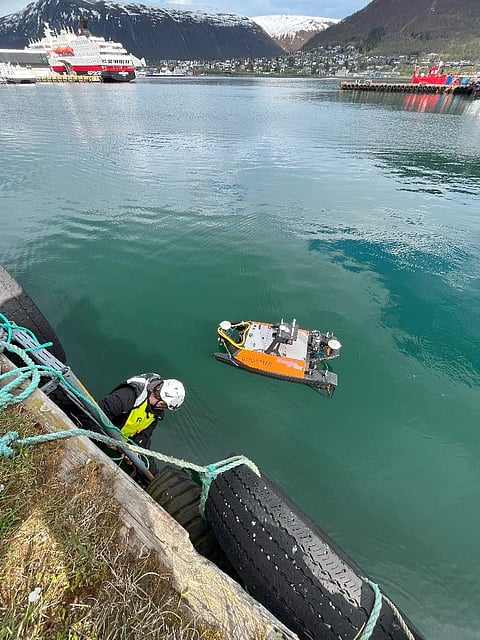Akvaplan-niva's Field Engineer Runar Warberg and the USV Otter in Tromsø harbour.
Photo: Pierre Priou / Akvaplan-niva.
Akvaplan-niva to map kelp forests using sonar
As the Ocean Green project explains, in northern Norway, more than 80% of the original kelp forests have disappeared in the last 50 years, being replaced by sea urchins as a consequence of overfishing of their natural predators and climate change. The project is helping to restore them, and the development of Akvaplan-niva to map kelp forests using sonar is part of this effort.
The company's ultimate goal is to develop software used to map kelp forests and estimate their density and biomass, an approach that will allow monitoring kelp recovery after sea urchin removal.
Creating high-resolution 3D maps
Specifically, the development Akvaplan-niva is working on is the search for new methods to map kelp forests using sonar. Called multibeam echosounders, these sonars are traditionally used for bathymetry mapping, but in this case, the aquaculture research and environmental consultancy company uses them to record data from the water column in addition to the seafloor.
As shown in the figure below, this sonar system works by emitting multiple acoustic beams in a fan shape, covering a wide area called a swath. The pulse of sound – a "ping" – emitted by the echosounder travels through the water, reflects off the seafloor or objects within the water column, such as a kelp, and is received by the echosounder.
Then, the multibeam echosounder measures the time it takes for the sound to return, along with the angle of each beam, and calculates the depth of the objects, creating high-resolution 3D maps of the area.
Schematic of the Akvaniva-plan sonar system operation.
Illustration: Pierre Priou / Akvaplan-niva.
Combining sonar and hand count data
In this case, Akvaplan-niva mounted the multibeam echosounder on a small unmanned surface vehicle (USV), the Otter from Maritime Robotics. In addition, it was equipped with a camera system to visually confirm what was observed with acoustics. The Otter's small size facilitates mapping shallow areas that would be inaccessible to a larger vessel.
The company deployed the USV on June 2nd outside of the Framsenteret - The Fram Centre, High North Research Centre for Climate and the Environment - to collect multibeam echosounder data. Alongside the Otter, Pernilla Carlsson from NIVA conducted a visual free-diving survey and manually counted kelps.
Akvaplan-niva explained that the combined sonar and hand count data will help develop software used to map kelp forests and estimate their density and biomass. This approach, the company added, will allow monitoring of kelp recovery after urchin removal.
Pernilla Carlsson (NIVA) with a kelp during the visual free-diving survey.
Photo: Pierre Priou / Akvaplan-niva.
Kelp forests' value beyond sea urchins
As said above, in the last 50 years, more than 80% of Norway's original kelp forests have disappeared, replaced instead by urchin barrens, and Ocean Green is helping to restore the kelp forests while boosting biodiversity and finding new commercially viable uses for sea urchins.
As a pioneer of restorative aquaculture, Brian Tsuyoshi Takeda - founder of Urchinomics, co-founder of Restorae, and a kelp forest restoration advocate - explained some time ago to WeAreAquaculture, empty urchins have no economic value, but those same urchins overharvest kelp forests and ruin the foundations of all kinds of coastal fisheries, so when kelp forests grow back, so do all the fish that disappeared, which benefits fishermen and their communities.
But not only that, kelp forests are also one of the most diverse ecosystems on Earth, protecting coastlines and acting as a carbon sink in the fight against climate change, a topic Takeda himself will speak about today on behalf of the Japan Blue Economy Association and the Kelp Forest Foundation at Seagriculture EU 2025, being held today and tomorrow in Rotterdam, the Netherlands, which WeAreAquaculture is reporting live.


